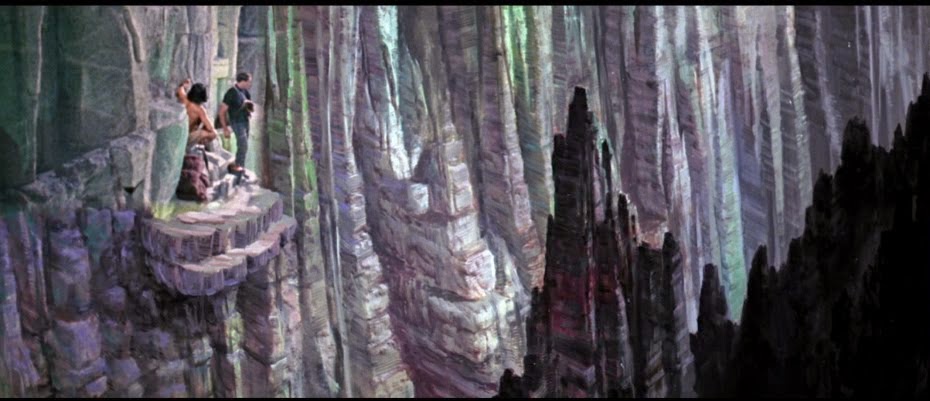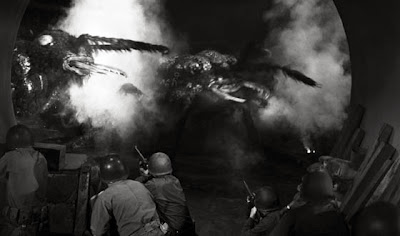After a high-flying first film in the franchise – due in large part to director John Milius’s symbolic visuals -- the cinematic Conan saga loses some dramatic altitude with this average but not disastrous follow-up, 1984’s Conan the Destroyer.
The sequel film, now 40 years old, is a fairly innocuous -- but also fairly childish -- adventure that adopts the wrong tack in terms of Conan’s motivations, and ham-handedly defines him as a gullible hulk rather than as a cunning warrior.
In short, it’s difficult to believe Conan would become involved in this adventure’s “quest,” especially for the specific reasons that he does. The literary Conan -- and the Conan of Milius’s film -- would know better.
Furthermore, the precise quest that Conan undertakes in this film from Richard Fleischer -- while picturesque at times thanks to some good 1980s special effects -- nonetheless feels like a tightly-budgeted one.
Specifically, the major battle sequences are all small potatoes in scope and execution… especially compared to Conan the Barbarian. These fights are relatively uninvolving affairs shot with little distinction, on small sets, and featuring uninspiring creatures that Conan would easily dispatch under many circumstances.
Also, the film abandons the principle of preparedness by which Conan defeated the legions of Thulsa Doom in the finale of Conan the Barbarian. Thus the fights here seem more like impromptu wrestling matches than warrior-against-warrior combat.
With some rather under-compelling performers in the secondary roles, Conan the Destroyer just feels a lot like a middling, second-rate sequel to a legitimate masterpiece. It’s not a Superman III (1983) or Superman IV (1986) styled disaster, to be certain, but the second Conan film nonetheless disappoints, falling far short of its superior model.
“We shall both have everything we want through magic.”
Queen Taramis (Sarah Douglas) of Shadizar recruits the great warrior Conan (Arnold Schwarzenegger) for a quest. After promising Conan that she can resurrect his lost love, Valeria, she entices him to take her niece, Jehnna (Olivia D’Abo) to retrieve a sacred jewel that can awaken Dagoth, the “dreaming God.”
Conan, with his sidekick, Malak the Thief (Tracey Walter) agrees to Taramis’s terms, even though the warrior is not thrilled to be accompanied by the captain of the Queen’s guard, Bombaata (Wilt Chamberlain).
Conan is also unaware that Taramis’s true plan involves sacrificing Jehnna in order to awaken Dagoth.
After recruiting his wizard friend Akiro (Mako) from cannibals, and freeing Zula (Grace Jones) -- a warrior facing down angry villagers that she has robbed -- Conan and his team retrieve the jewel from the castle of Toth-Amon (Pat Roach). In a Hall of Mirrors, Conan defeats the wizard in close quarters combat.
Later, at an ancient temple, Jehnna and Conan retrieve the horn of Dagoth, and Bombaata springs his trap, abducting Jehnna and taking her prize back to Queen Taramis.
Conan rides back to Shadizar to save Jehnna, and to stop the monstrous Dagoth…who has awakened to wreak havoc on the world of man.
“It seems that men like women warriors.”
It appears that many of Conan the Destroyer’s problems arise with the basic premise, and Conan’s participation in this particular adventure.
Specifically, Taramis promises Conan that she can return Valeria to him, and Conan much too easily accepts both the possibility of such a resurrection, and the Queen’s motivations for delivering on her promise.
The Conan of literature and film has always had a tremendous suspicion of magic, and yet here he decides to undertake a quest which will have magical results (the re-birth of a God…), so that he can be the beneficiary of other magical results (the re-birth of his would-be queen).
In short, it just doesn’t seem like Conan to take Taramis at her word about such a grave matter. He should be more suspicious of the Queen and her promises, especially given Sarah Douglas’s haughty (but good…) performance. She doesn’t exactly inspire trust.
Conan should know that Valeria cannot return to him and that even if she could, it would be…unnatural.
A better screenplay might have been tweaked to reflect the idea that Conan undertakes this quest for different reasons, ones entirely his own, and probably concerning the fact that he senses a terrible danger.
Or, simply, the screenplay might have had one scene -- just one scene -- in which Conan questioned the use of magic to restore Valeria.
Under those circumstances would Valeria want to be restored?
Conan -- Valeria’s soul mate -- would know the answer instinctively.
Beyond Conan’s willingness to accept that his beloved Valeria can and will return to him, I find it highly unlikely that this warrior would go on a quest in which the end game is, quite clearly, resurrecting a slumbering God.
Conan has almost as little use for Gods as he does for magic.
So why would Conan agree to help recover an object that could bring about the reign of a dark, monstrous figure, even if he doesn’t know the specifics of how dark or how monstrous the revived Dagoth would actually be?
Arnold Schwarzenegger is once again much more than satisfactory as Conan, but there are times during the film when the adventure seems more appropriate to some other fantasy character, not the man from Cimmeria. Conan the Barbarian dramatized the story of how Conan was forged and tempered, how he became a man. It was a vital story to tell. Conan the Destroyer plays like a boiler-plate adventure, and not one that is particularly notable in Conan’s life.
It’s also plain -- since this film is rated PG, not R -- that Conan the Destroyer begins the unfortunate process of mainstreaming Conan, of making him “acceptable” to parents and other establishment figures worried about “morality.”
To wit, there is almost no sex in the film at all. Conan is absolutely chaste here. There are no interludes like the kinky one with the witch/demon in Conan the Barbarian. One might argue that Conan is in mourning, of course, but sex has been subtracted not just from his character, but from the film’s very DNA.
Similarly, there is much less gore here than in the previous film, though we do witness Conan’s decapitation of a cannibal while saving the wizard. The violence is all just more…palatable, and therefore less involving, and less exciting.
The straight-forward, kiddie-friendly approach to the Conan universe might have worked more effectively if there was a larger, more spectacular background tapestry upon which to rely. Although there are some impressive shots in the film of animal bones in the desert, and mystical and mysterious kingdoms, the big action set-pieces prove remarkable unmemorable.
The Hall of Mirrors sequence doesn’t make a lot of sense given the way the special effects play out, because Conan is able to determine which “reflection” is the real monster without hardship or confusion.
Secondly, the creature’s make-up in this scene is horrible.
And thirdly, this sequence is one of the movie’s two big fights, and it occurs in a small room, and with almost no elaboration or detail. It’s just a grudge match.
Worse, the climax in the Queen’s kingdom plays as a repeat of Hall of Mirrors battle. Dagoth awakes, and he looks like a Dark God as imagined by H.P. Lovecraft. But he is no more difficult to put down than the mirror creature was. And again, the battle takes place in one room, with Conan indulging, basically, in one-on-one combat. It just feels very small potatoes, very rushed, especially compared, again, to the first film’s set-pieces.
I have read that some critics and viewers have a problem with Grace Jones’ character, Zula, but for me, she worked just fine. Zula doesn’t talk too much, she’s useful in a fight, and there’s no sentimentalizing of the character to any significant degree. She’s the kind of sidekick I prefer in such fare: a capable and loyal fighter who doesn’t feel the need to crack jokes all the time.
For me, the characters who don’t work are, primarily, Malak and Bombaata. Malak is second-rate comic relief, and not particularly useful in a fight, or any other pinch, which makes one wonder why Conan keeps him around.
In Wilt Chamberlain’s hands, Bombaata lacks any sense of genuine menace at all, either physical or psychological. He just comes off as…flat.
Meanwhile, Olivia D’Abo has the thankless task of playing the Lynn Holly Johnson (For Your Eyes Only) role to Schwarzenegger’s Conan, lusting eternally after him, but too young for the barbarian to take seriously as a sexual conquest. D’Abo is capable in the role, but again, Jehnna is not particularly well-defined. She knows all aspects of the Dagoth legend by heart, except the particulars of her role in it?
There’s a whole lot of walkin’ in Conan the Destroyer (a flaw in many modern fantasy films, I find…), and while the scenery is relatively beautiful, the relative “emptiness” of the narrative leaves one time to ponder how disappointing the film is, or how out-of-character Conan seems, or how the film might have been better without some of the stunt casting, like Chamberlain.
Less audacious, less raunchy, less downright naughty than Conan the Barbarian, this 1984 sequel is straight-forward and often fun, but it is not the Conan sequel most of us hoped for, even with Arnold Schwarzenegger inhabiting the role for a second time.
The first film remains a work of pop art of the first order, a magnificent epic that comments on aspects of our society, and which conveys its meaning through deftly-executed symbolic imagery.
Conan the Destroyer’s approach is entirely more mundane and workman-like. The movie entertains moderately, moment-to-moment, but that is not accomplishment near grand enough for this particular barbarian.









































